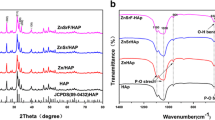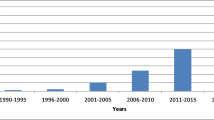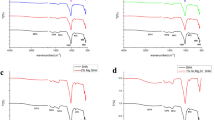Abstract
The main inorganic minerals in natural bones are non-stoichiometric hydroxyapatite (HA, Ca10[PO4]6[OH]2) doped with various trace elements, which may possess important biochemical effects. To investigate the functions of Sr and Si elements in human hard tissues, non-doped HA, trace Si doped HA, Si and Sr codoped HA with the concentration of natural bones are synthesized by hydrothermal method in this study. The samples are characterized by powder X-ray diffraction (XRD), Fourier transform infrared spectroscopy (FTIR), and scanning electron microscope (SEM). The biological activities are evaluated via cytotoxicity study, adhesion and proliferation of osteoblast measurement, and alkaline phosphatase (ALP) assay. All the synthesized materials are HA phase, which have hierarchical structures with oriented HA nanorods assembled into the platy particles. These materials are non-cytotoxic against L929 cells line even at 400 μg/ml powder suspension. The results clearly indicate that the proliferation of L929 cells increases with trace elements doping from trace Si-HA to Si + Sr-HA. The adhesion and proliferation of osteoblast measurement illustrates that proliferation of osteoblasts advances about 1.3 times for Si-HA and about 1.8 times for Si + Sr-HA compared with undoped HA. In general, Si-HA with trace Si element shows enhanced cell differentiation, and Si + Sr-HA dual-doped with Si and Sr elements presents increased biological activity compared with Si-HA.










Similar content being viewed by others
References
Vallet-Regi M, Arcos D (2005) Silicon substituted hydroxyapatites. A method to upgrade calcium phosphate based implants. J Mater Chem 15:1509–1516
Tomoaia G, Soritau O, Tomoaia-Cotisel M, Pop LB, Pop A, Mocanu A, Horovitz O, Bobos LD (2013) Scaffolds made of nanostructured phosphates, collagen and chitosan for cell culture. Powder Technol 238:99–107
Zhong JP, Greenspan DC (2000) Processing and properties of sol-gel bioactive glasses. J Biomed Mater Res 53:694–701
Oonishi H, Hench LL, Wilson J, Sugihara F, Tsuji E, Matsuura M, Kin S, Yamamoto T, Mizokawa S (2000) Quantitative comparison of bone growth behavior in granules of Bioglass (R), A-W glass-ceramic, and hydroxyapatite. J Biomed Mater Res 51:37–46
Fischer A, Wiechula D, Postek-Stefanska L, Kwapulinski J (2009) Concentrations of metals in maxilla and mandible deciduous and permanent human teeth. Biol Trace Elem Res 132:19–26
Evis Z, Webster TJ (2011) Nanosize hydroxyapatite: doping with various ions. Adv Appl Ceram 110:311–320
Mocanu A, Furtos G, Rapuntean S, Horovitz O, Flore C, Garbo C, Danisteanu A, Rapuntean G, Prejmerean C, Tomoaia-Cotisel M (2014) Synthesis; characterization and antimicrobial effects of composites based on multi-substituted hydroxyapatite and silver nanoparticles. Appl Surf Sci 298:225–235
Thian ES, Huang J, Best SM, Barber ZH, Brooks RA, Rushton N, Bonfield W (2006) The response of osteoblasts to nanocrystalline silicon-substituted hydroxyapatite thin films. Biomaterials 27:2692–2698
Porter AE, Patel N, Skepper JN, Best SM, Bonfield W (2003) Comparison of in vivo dissolution processes in hydroxyapatite and silicon-substituted hydroxyapatite bioceramics. Biomaterials 24:4609–4620
Tang XL, Xiao XF, Liu RF (2005) Structural characterization of silicon-substituted hydroxyapatite synthesized by a hydrothermal method. Mater Lett 59:3841–3846
Tomoaia G, Tomoaia-Cotisel M, Pop L-B, Pop A, Horovitz O, Mocanu A, Jumate N, Bobos L-D (2011) Synthesis and characterization of Some composites based on nanostructured phosphates, collagen and chitosan. Rev Roum Chim 56:1039–1046
Tomoaia G, Mocanu A, Vida-Simiti I, Jumate N, Bobos L-D, Soritau O, Tomoaia-Cotisel M (2014) Silicon effect on the composition and structure of nanocalcium phosphates in vitro biocompatibility to human osteoblasts. Mater Sci Eng, C 37:37–47
Okayama S, Akao M, Nakamura S, Shin Y, Higashikata M, Aoki H (1991) The mechanical properties and solubility of strontium-substituted hydroxyapatite. Bio-Med Mater Eng 1:11–17
Rautray TR, Mohapatra B, Kim K-H (2014) Fabrication of strontium–hydroxyapatite scaffolds for biomedical applications. Adv Sci Lett 20:879–881
Wu C, Chen Z, Yi D, Chang J, Xiao Y (2014) Multidirectional effects of Sr-, Mg-, and Si-Containing Bioceramic coatings with high bonding strength on inflammation, osteoclastogenesis, and osteogenesis. ACS Appl Mater Interfaces 6:4264–4276
Balamurugan A, Rebelo AHS, Lemos AF, Rocha JHG, Ventura JMG, Ferreira JMF (2008) Suitability evaluation of sol-gel derived Si-substituted hydroxyapatite for dental and maxillofacial applications through in vitro osteoblasts response. Dent Mater 24:1374–1380
Xue W, Hosick HL, Bandyopadhyay A, Bose S, Ding C, Luk KDK, Cheung KMC, Lu WW (2007) Preparation and cell-materials interactions of plasma sprayed strontium-containing hydroxyapatite coating. Surf Coat Technol 201:4685–4693
Capuccini C, Torricelli P, Sima F, Boanini E, Ristoscu C, Bracci B, Socol G, Fini M, Mihailescu IN, Bigi A (2008) Strontium-substituted hydroxyapatite coatings synthesized by pulsed-laser deposition: in vitro osteoblast and osteoclast response. Acta Biomater 4:1885–1893
Kendler DL (2006) Strontium ranelate–data on vertebral and nonvertebral fracture efficacy and safety: mechanism of action. Curr Osteoporos Rep 4:34–39
Chung C-J, Long H-Y (2011) Systematic strontium substitution in hydroxyapatite coatings on titanium via micro-arc treatment and their osteoblast/osteoclast responses. Acta Biomater 7:4081–4087
Zhang W, Shen Y, Pan H, Lin K, Liu X, Darvell BW, Lu WW, Chang J, Deng L, Wang D, Huang W (2011) Effects of strontium in modified biomaterials. Acta Biomater 7:800–808
Naveau B (2004) Strontium: a new treatment for osteoporosis. Jt, Bone, Spine 71:261–263
Tohno Y, Tohno S, Utsumi M, Minami T, Ichii M, Okazaki Y, Nishiwaki F, Moriwake Y, Naganuma T, M-o Y (1997) Age-independent constancy of mineral contents in human vertebra and auditory ossicle. Biol Trace Elem Res 59:167–175
Samek O, Beddows DCS, Telle HH, Kaiser J, Liska M, Caceres JO, Urena AG (2001) Quantitative laser-induced breakdown spectroscopy analysis of calcified tissue samples. Spectrochim Acta, Part B 56:865–875
Christoffersen J, Christoffersen MR, Kolthoff N, Barenholdt O (1997) Effects of strontium ions on growth and dissolution of hydroxyapatite and on bone mineral detection. Bone 20:47–54
Li ZY, Lam WM, Yang C, Xu B, Ni GX, Abbah SA, Cheung KMC, Luk KDK, Lu WW (2007) Chemical composition, crystal size and lattice structural changes after incorporation of strontium into biomimetic apatite. Biomaterials 28:1452–1460
Wang M, Gao J, Shi C, Zhu Y, Zeng Y, Wang D (2014) Facile One-Pot synthesis of oriented pure hydroxyapatite with hierarchical architecture by topotactic conversion. Cryst Growth Des 14:6459–6466
Shi C, Gao J, Wang M, Fu J, Wang D, Zhu Y (2015) Ultra-trace silver-doped hydroxyapatite with non-cytotoxicity and effective antibacterial activity. Mater Sci Eng, C 55:497–505
Wang Z, Telci D, Griffin M (2011) Importance of syndecan-4 and syndecan-2 in osteoblast cell adhesion and survival mediated by a tissue transglutaminase-fibronectin complex. Exp Cell Res 317:367–381
Sun J, Li J, Liu X, Wei L, Wang G, Meng F (2009) Proliferation and gene expression of osteoblasts cultured in DMEM containing the ionic products of dicalcium silicate coating. Biomed Pharmacother 63:650–657
Barbara A, Delannoy P, Denis BG, Marie PJ (2004) Normal matrix mineralization induced by strontium ranelate in MC3T3-E1 osteogenic cells. Metab Clin Exp 53:532–537
Marie PJ, Ammann P, Boivin G, Rey C (2001) Mechanisms of action and therapeutic potential of strontium in bone. Calcif Tissue Int 69:121–129
Zhang EL, Zou CM (2009) Porous titanium and silicon-substituted hydroxyapatite biomodification prepared by a biomimetic process: characterization and in vivo evaluation. Acta Biomater 5:1732–1741
Anselme K (2000) Osteoblast adhesion on biomaterials. Biomaterials 21:667–681
Thian ES, Huang J, Best SM, Barber ZH, Bonfield W (2005) Magnetron co-sputtered silicon-containing hydroxyapatite thin films—an in vitro study. Biomaterials 26:2947–2956
Ni G-X, Yao Z-P, Huang G-T, Liu W-G, Lu WW (2011) The effect of strontium incorporation in hydroxyapatite on osteoblasts in vitro. J Mater Sci Mater Med 22:961–967
Lin K, Liu P, Wei L, Zou Z, Zhang W, Qian Y, Shen Y, Chang J (2013) Strontium substituted hydroxyapatite porous microspheres: surfactant-free hydrothermal synthesis, enhanced biological response and sustained drug release. Chem Eng J 222:49–59
Zhang E, Zou C, Yu G (2009) Surface microstructure and cell biocompatibility of silicon-substituted hydroxyapatite coating on titanium substrate prepared by a biomimetic process. Mater Sci Eng, C 29:298–305
Leventouri T, Bunaciu CE, Perdikatsis V (2003) Neutron powder diffraction studies of silicon-substituted hydroxyapatite. Biomaterials 24:4205–4211
Liu X, Morra M, Carpi A, Li B (2008) Bioactive calcium silicate ceramics and coatings. Biomed Pharmacother 62:526–529
Thian ES, Huang J, Best SM, Barber ZH, Bonfield W (2006) Silicon-substituted hydroxyapatite thin films: effect of annealing temperature on coating stability and bioactivity. J Biomed Mater Res, Part A 78A:121–128
Zhang Z, Sun J, Hu H, Wang Q, Liu X (2011) Osteoblast-like cell adhesion on porous silicon-incorporated TiO2 coating prepared by micro-arc oxidation. J Biomed Mater Res, Part B 97B:224–234
Bigi A, Boanini E, Capuccini C, Gazzano M (2007) Strontium-substituted hydroxyapatite nanocrystals. Inorg Chim Acta 360:1009–1016
Wong CT, Chen QZ, Lu WW, Leong JCY, Chan WK, Cheung KMC, Luk KDK (2004) Ultrastructural study of mineralization of a strontium-containing hydroxyapatite (Sr-HA) cement in vivo. J Biomed Mater Res, Part A 70A:428–435
Caverzasio J (2008) Strontium ranelate promotes osteoblastic cell replication through at least two different mechanisms. Bone 42:1131–1136
Saidak Z, Marie PJ (2012) Strontium signaling: molecular mechanisms and therapeutic implications in osteoporosis. Pharmacol Ther 136:216–226
Coulombe J, Faure H, Robin B, Ruat M (2004) In vitro effects of strontium ranelate on the extracellular calcium-sensing receptor. Biochem Biophys Res Commun 323:1184–1190
Acknowledgments
This research is supported by the National Natural Science Foundation of China (No. 51232007; No. 51572283; No. 51072217) and the Science and Technology Commission of Shanghai Municipality (No. 08JC1420700 and No. 11XD1405600).
Author information
Authors and Affiliations
Corresponding author
Rights and permissions
About this article
Cite this article
Gao, J., Wang, M., Shi, C. et al. Synthesis of trace element Si and Sr codoping hydroxyapatite with non-cytotoxicity and enhanced cell proliferation and differentiation. Biol Trace Elem Res 174, 208–217 (2016). https://doi.org/10.1007/s12011-016-0697-0
Received:
Accepted:
Published:
Issue Date:
DOI: https://doi.org/10.1007/s12011-016-0697-0




